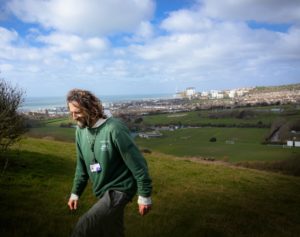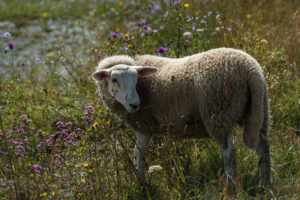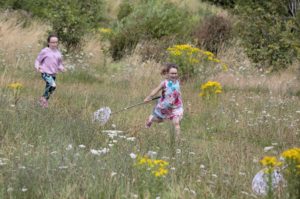Poignant video reveals ranger’s love of ‘magical’ South Downs landscape
April 24, 2020
As Paul Gorringe gazes out at the beautiful flower-studded chalk grassland, he knows he’s found his own little piece of heaven.
Paul sees it as an honour and privilege to be a custodian of the landscape in and around the South Downs National Park, helping to continue a millennia-old tradition that has helped to create one of the rarest habitats on planet Earth.
Within stone’s throw of the bustling city of Brighton and Hove is his favourite place – Whitehawk Hill and Sheepcote Valley. A tranquil haven of flora and fauna, it is also a hub for the community – where people come together to connect with the landscape and, furthermore, conserve and enhance it.
 As a ranger for Brighton & Hove City Council, Paul oversees a sheep grazing project that sees dozens of volunteer shepherds – or lookerers – help to maintain the landscape through conservation grazing.
As a ranger for Brighton & Hove City Council, Paul oversees a sheep grazing project that sees dozens of volunteer shepherds – or lookerers – help to maintain the landscape through conservation grazing.
Sheep are at the heart of the story of the creation of the South Downs landscape since the arrival of the first farmers from Europe some 4,500 years ago.
Stone Age farmers cleared the natural forest using flint-bladed tools, providing timber and grazing land for their animals.
A combination of sheep grazing over several hundred years and a chalky soil created short, springy grassland.
Today it is a biodiversity oasis – with up to 45 different species of flowering plants and mosses per square metre and at least 20 species of butterfly on the wing at any time during the summer.
Paul, a dad-of-two from Portslade, features in a new inspiring video that explains his love of this special landscape and how sheep, and people, are vital for its survival.
“The wildlife of this area is extremely rich,” says Paul.
“Chalk downland is known as a rainforest in miniature and it really is a case of getting down on your knees and discovering this huge biomass of plants and insects.
 “When the sheep industry died off, getting on for 100 years or so now, we started to lose our Downs. So what we decided to do was bring back the animals that helped open up the Downs in the first place, thousands of years ago.
“When the sheep industry died off, getting on for 100 years or so now, we started to lose our Downs. So what we decided to do was bring back the animals that helped open up the Downs in the first place, thousands of years ago.
“We developed a volunteer programme called the ‘Lookering’ or grazing project and it basically means we have volunteer shepherds. Their role is to come and have a look at the sheep, get the sheep up and moving, check the fences and check the water supply is working.
“We don’t exclude people – we want people to come through, even with their dogs, obviously on a lead is preferable.
“Many people have just never been up here before and when they come there’s a real wow factor.
“How can you not love a place like the South Downs – especially one that’s so connected to the city and the sea? I think it’s magical.”
Lookerers attend a full day of training, covering topics such as why we graze, the history of the Downs, livestock welfare and the law, as well as a practical session on one of the grazing sites them to the sheep flock and demonstrate how to keep the animals safe and healthy.
Only 45 per cent of chalk grassland in the National Park is designated as SSSI, meaning that over half does not benefit from significant legal protection.
 Paul is passionate about community engagement and raising awareness of the wonders of this habitat, which makes up four per cent of the National Park.
Paul is passionate about community engagement and raising awareness of the wonders of this habitat, which makes up four per cent of the National Park.
Last year more than 1,700 people came to the National Park’s Wild Chalk event at East Brighton Park which Paul helped to organise. As part of the day he brought his sheep down so people could learn more. It was a day of fun, learning and inspiration, with people of all ages eager to find out more about this amazing landscape on their doorstep.
Paul adds: “These two hills are where I cut my teeth as a ranger and as a naturalist.
“It’s where I learned to engage with people and to get people involved in the sites themselves, rather than just coming up to visit, actually volunteering and having their own sense of ownership of these green spaces.”
And it’s not only flowers that blossom on these hills.
Recalling in the film how love blossomed, Paul recalls: “Both of these hills are very special to me – there’s a romantic edge for me personally as I met my wife here 11 years ago.
“A new batch of volunteers came in through the ranger team and one of them in particular was interested in butterflies and wildflowers. Love blossomed over the summer, surveying for butterflies and chasing insects around the hills. We married several years ago and we now have two little boys.”
Paul’s video is part of new series of short films about the South Downs to mark the National Park’s 10th anniversary.
The “Your National Park” clips feature dedicated local heroes of the National Park, including foresters, farmers, historians and local people, who collectively are helping to care for this special place and ensure it will be there for future generations to enjoy.
Each hero represents one of the outcomes of the Partnership Management Plan – which was unveiled by the National Park Authority today and reveals 10 key objectives for the future of the National Park.
